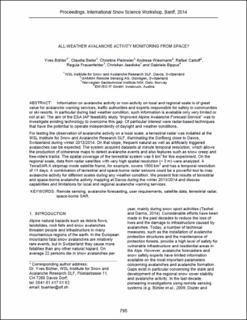| dc.contributor.author | Bühler, Yves | |
| dc.contributor.author | Bieler, Claudia | |
| dc.contributor.author | Pielmeier, Christine | |
| dc.contributor.author | Wiesmann, Andreas | |
| dc.contributor.author | Caduff, Rafael | |
| dc.contributor.author | Frauenfelder, Regula | |
| dc.contributor.author | Jaedicke, Christian | |
| dc.contributor.author | Bippus, Gabriele | |
| dc.date.accessioned | 2023-08-10T08:09:34Z | |
| dc.date.available | 2023-08-10T08:09:34Z | |
| dc.date.issued | 2014 | |
| dc.identifier.uri | https://hdl.handle.net/11250/3083293 | |
| dc.description.abstract | Information on avalanche activity or on non-activity on local and regional scale is of great value for avalanche warning services, traffic authorities and experts responsible for safety in communities or ski resorts. In particular during bad weather condition, such information is available only very limited or not at all. The aim of ESA IAP feasibility study "Improved Alpine Avalanche Forecast Service" was to investigate existing technology to overcome this gap. Of particular interest were radar-based techniques that have the potential to operate independently of daylight and weather conditions. | en_US |
| dc.language.iso | eng | en_US |
| dc.publisher | Montana State University Library | en_US |
| dc.relation.ispartofseries | The International Snow Science Workshop (ISSW) Proceedings; | |
| dc.subject | Avalanche-RnD | en_US |
| dc.subject | Snøskred-FoU | en_US |
| dc.title | All-weather avalanche activity monitoring from space? | en_US |
| dc.type | Chapter | en_US |
| dc.source.pagenumber | 8 | en_US |
| dc.identifier.doi | https://arc.lib.montana.edu/snow-science/item/2153 | |
